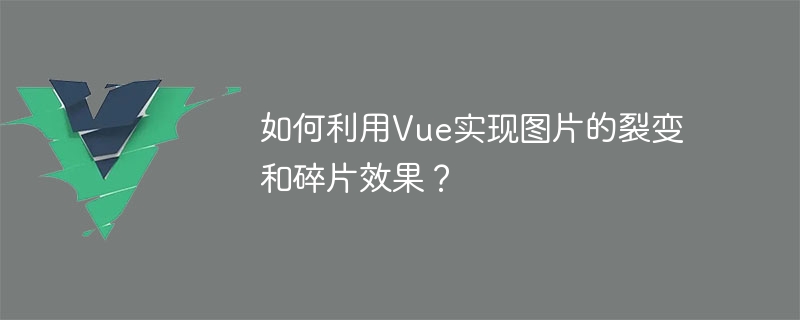Vue를 사용하여 이미지의 분열 및 조각화 효과를 얻는 방법은 무엇입니까?
- WBOYWBOYWBOYWBOYWBOYWBOYWBOYWBOYWBOYWBOYWBOYWBOYWB원래의
- 2023-08-25 20:31:491099검색

Vue를 사용하여 이미지의 분열 및 조각화 효과를 얻는 방법은 무엇입니까?
프런트 엔드 개발에서는 사용자 경험을 향상시키기 위해 웹 페이지에 특수 효과를 추가해야 하는 경우가 많습니다. 그 중 사진의 핵분열 및 단편화 효과는 가장 일반적인 특수 효과 중 하나입니다. 이 글에서는 Vue 프레임워크를 사용하여 이미지의 분열 및 조각화 효과를 구현하는 방법을 소개하고 관련 코드 예제를 첨부합니다.
- 준비
먼저 효과 표시 대상으로 사진을 준비해야 합니다. Vue 프로젝트에서 이미지는assets폴더에 저장되고 구성 요소에서 참조될 수 있습니다.assets文件夹中,并在组件中引用。 - 创建Vue组件
接下来,我们需要创建一个Vue组件来实现图片的裂变和碎片效果。在组件的template中,可以使用<img src="/static/imghwm/default1.png" data-src="imageUrl" class="lazy" alt="Vue를 사용하여 이미지의 분열 및 조각화 효과를 얻는 방법은 무엇입니까?" >标签来展示图片。同时,为了实现裂变和碎片效果,我们需要在data中定义一些状态值来控制动画效果的展示。
<template>
<div>
<img src="/static/imghwm/default1.png" data-src="imageUrl" class="lazy" : : style="max-width:90%" alt="" />
<div class="particles" :style="particleStyle" v-if="showParticles"></div>
</div>
</template>
<script>
export default {
data() {
return {
imageUrl: require('@/assets/image.jpg'), // 替换成你的图片地址
imageStyle: {
width: '500px', // 根据图片大小设置宽度
height: 'auto', // 根据图片宽高比计算高度
position: 'relative',
},
particleStyle: {
position: 'absolute',
width: '10px',
height: '10px',
background: 'red', // 碎片的颜色
},
showParticles: false, // 是否展示碎片
}
},
mounted() {
// 设置一个定时器,在3秒后展示碎片效果
setTimeout(() => {
this.showParticles = true;
}, 3000);
},
}
</script>
<style scoped>
.particles {
width: 100%;
height: 100%;
overflow: hidden;
}
</style>- 实现裂变效果
要实现图片的裂变效果,我们可以在mounted钩子中使用canvas来处理图片。具体步骤如下:
- 创建一个
canvas元素,并设置与图片相同的宽高。 - 获取
canvas的上下文并使用drawImage方法将图片绘制到canvas上。 - 使用
getImageData方法获取图片的像素数据,然后对每个像素进行处理。 - 根据像素的位置和颜色,使用
fillRect方法在canvas上绘制一个个小的矩形,形成裂变效果。
以下是裂变效果的代码示例:
<template>
<div>
<canvas ref="canvas" :width="canvasWidth" :height="canvasHeight" />
<div class="particles" :style="particleStyle" v-if="showParticles"></div>
</div>
</template>
<script>
export default {
data() {
return {
imageUrl: require('@/assets/image.jpg'), // 替换成你的图片地址
imageStyle: {
width: '500px', // 根据图片大小设置宽度
height: 'auto', // 根据图片宽高比计算高度
position: 'relative',
},
particleStyle: {
position: 'absolute',
width: '10px',
height: '10px',
background: 'red', // 碎片的颜色
},
canvasWidth: 500,
canvasHeight: 0,
showParticles: false, // 是否展示碎片
}
},
mounted() {
const canvas = this.$refs.canvas;
const ctx = canvas.getContext('2d');
const img = new Image();
img.src = this.imageUrl;
img.onload = () => {
this.canvasHeight = (img.height * this.canvasWidth) / img.width;
canvas.width = this.canvasWidth;
canvas.height = this.canvasHeight;
ctx.drawImage(img, 0, 0, this.canvasWidth, this.canvasHeight);
const imageData = ctx.getImageData(0, 0, this.canvasWidth, this.canvasHeight);
const pixels = imageData.data;
// 对每个像素进行处理
for (let i = 0; i < pixels.length; i += 4) {
const r = pixels[i];
const g = pixels[i + 1];
const b = pixels[i + 2];
const a = pixels[i + 3];
const x = (i / 4) % this.canvasWidth;
const y = Math.floor(i / 4 / this.canvasWidth);
if (Math.random() < 0.5) {
ctx.fillStyle = `rgba(${r},${g},${b},${a / 255})`;
ctx.fillRect(x, y, 1, 1);
}
}
// 定时器,在3秒后展示碎片效果
setTimeout(() => {
this.showParticles = true;
}, 3000);
};
},
}
</script>- 实现碎片效果
要实现图片的碎片效果,我们可以在data中定义一些变量来控制碎片的数量和位置。然后,在mounted钩子中使用v-forVue 구성 요소 만들기
템플릿에서 <img alt="Vue를 사용하여 이미지의 분열 및 조각화 효과를 얻는 방법은 무엇입니까?" > 태그를 사용하여 이미지를 표시할 수 있습니다. 동시에 핵분열 및 단편화 효과를 얻으려면 데이터에 일부 상태 값을 정의하여 애니메이션 효과 표시를 제어해야 합니다. <template>
<div>
<canvas ref="canvas" :width="canvasWidth" :height="canvasHeight" />
<div class="particles" v-if="showParticles">
<div
class="particle"
:class="'particle-' + index"
v-for="(particle, index) in particles"
:key="index"
:style="{ left: particle.x + 'px', top: particle.y + 'px', animationDelay: particle.delay + 'ms' }"
></div>
</div>
</div>
</template>
<script>
export default {
data() {
return {
imageUrl: require('@/assets/image.jpg'), // 替换成你的图片地址
imageStyle: {
width: '500px', // 根据图片大小设置宽度
height: 'auto', // 根据图片宽高比计算高度
position: 'relative',
},
particleStyle: {
position: 'absolute',
width: '10px',
height: '10px',
background: 'red', // 碎片的颜色
},
canvasWidth: 500,
canvasHeight: 0,
showParticles: false, // 是否展示碎片
particles: [], // 碎片数组
}
},
mounted() {
const canvas = this.$refs.canvas;
const ctx = canvas.getContext('2d');
const img = new Image();
img.src = this.imageUrl;
img.onload = () => {
this.canvasHeight = (img.height * this.canvasWidth) / img.width;
canvas.width = this.canvasWidth;
canvas.height = this.canvasHeight;
ctx.drawImage(img, 0, 0, this.canvasWidth, this.canvasHeight);
const imageData = ctx.getImageData(0, 0, this.canvasWidth, this.canvasHeight);
const pixels = imageData.data;
// 对每个像素进行处理
for (let i = 0; i < pixels.length; i += 4) {
const r = pixels[i];
const g = pixels[i + 1];
const b = pixels[i + 2];
const a = pixels[i + 3];
const x = (i / 4) % this.canvasWidth;
const y = Math.floor(i / 4 / this.canvasWidth);
if (Math.random() < 0.5) {
ctx.fillStyle = `rgba(${r},${g},${b},${a / 255})`;
ctx.fillRect(x, y, 1, 1);
}
}
// 初始化碎片数组
for (let i = 0; i < 1000; i++) {
const x = Math.random() * this.canvasWidth;
const y = Math.random() * this.canvasHeight;
const delay = Math.random() * 2000;
this.particles.push({
x,
y,
delay,
});
}
// 定时器,在3秒后展示碎片效果
setTimeout(() => {
this.showParticles = true;
}, 3000);
};
},
}
</script>
<style scoped>
.particles {
width: 100%;
height: 100%;
overflow: hidden;
}
.particle {
position: absolute;
width: 10px;
height: 10px;
background: red; // 碎片的颜色
animation: particle-fade 2s ease-in-out infinite;
}
@keyframes particle-fade {
0% {
opacity: 1;
transform: translateY(0);
}
50% {
opacity: 0;
transform: translateY(20px);
}
100% {
opacity: 1;
transform: translateY(0);
}
}
.particle-0 {
animation-delay: 50ms;
}
.particle-1 {
animation-delay: 100ms;
}
.particle-2 {
animation-delay: 150ms;
}
/* ... */
</style>핵분열 효과 달성
이미지의 핵분열 효과를 얻으려면마운트된 후크에서 캔버스를 사용하여 이미지를 처리할 수 있습니다. 구체적인 단계는 다음과 같습니다.
- 🎜
캔버스 요소를 생성하고 이미지와 동일한 너비와 높이를 설정합니다. 🎜🎜캔버스의 컨텍스트를 가져오고 drawImage 메서드를 사용하여 이미지를 캔버스에 그립니다. 🎜🎜getImageData 메서드를 사용하여 이미지의 픽셀 데이터를 얻은 다음 각 픽셀을 처리합니다. 🎜🎜fillRect 메서드를 사용하여 픽셀의 위치와 색상을 기반으로 캔버스에 작은 직사각형을 그려 핵분열 효과를 만듭니다. 🎜- 🎜조각화 효과를 얻으려면🎜이미지의 조각화 효과를 얻으려면
data 조각의 수와 위치를 제어하는 변수입니다. 그런 다음 mounted 후크에서 v-for 루프를 사용하여 조각을 생성하고 조각의 위치와 애니메이션을 설정합니다. 🎜🎜🎜다음은 조각화 효과의 코드 예제입니다. 🎜rrreee🎜위의 코드 예제를 사용하면 Vue에서 이미지의 핵분열 및 조각화 효과를 쉽게 구현할 수 있습니다. 페이지가 로드되면 이미지가 먼저 조각으로 나누어지고 일정 기간의 애니메이션이 끝난 후 최종적으로 전체 이미지가 표시됩니다. 원하는 효과를 얻기 위해 실제 필요에 따라 코드의 매개변수를 조정할 수 있습니다. 🎜🎜이 기사가 Vue의 이미지 분열 및 조각화 효과 구현을 이해하는 데 도움이 되기를 바랍니다! 🎜위 내용은 Vue를 사용하여 이미지의 분열 및 조각화 효과를 얻는 방법은 무엇입니까?의 상세 내용입니다. 자세한 내용은 PHP 중국어 웹사이트의 기타 관련 기사를 참조하세요!
성명:
본 글의 내용은 네티즌들의 자발적인 기여로 작성되었으며, 저작권은 원저작자에게 있습니다. 본 사이트는 이에 상응하는 법적 책임을 지지 않습니다. 표절이나 침해가 의심되는 콘텐츠를 발견한 경우 admin@php.cn으로 문의하세요.

